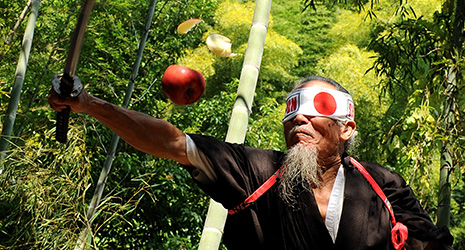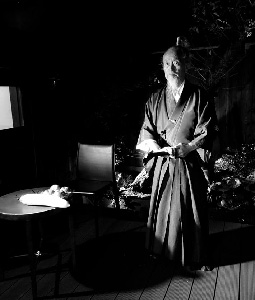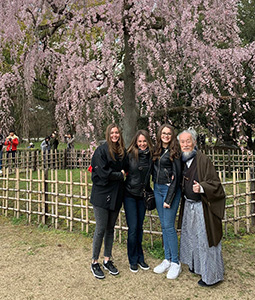INDEX
- English
- 日本語

Okada demonstrates kuchu ringo kiri (cutting apples in the air), the “culmination of all iaido (sword drawing) training,” according to Okada. - English
- 日本語

Okada leads foreign tourists on a tour of Kyoto

Joe Okada, aka the “Last Samurai” 
Okada leads foreign tourists on a tour of Kyoto
February 2021
The “Last Samurai” in Kyoto

Joe Okada is the oldest National Government Licensed Guide Interpreter working in Japan and a popular character with foreign tourists.

Joe Okada, who is 92 this year, works as a guide for foreigners in Kyoto and accompanies group tours to Hiroshima, Hakone and Tokyo. With his long hair tied in the topknot style, and dressed in haori and hakama (the formal jacket and trousers of traditional Japanese men’s clothing), his trademark look has earned him the nickname the “Last Samurai.” Okada shows foreign visitors around the city of Kyoto in fluent English peppered with a touch of humor. He has been a tour guide for 58 years.
Every Saturday until the beginning of 2020, prior to the impact of COVID-19, Okada led trips to Kyoto Imperial Palace on his “Cool Kyoto Walking Tour.” The tour is popular among foreign tourists for its focus on cultural experiences unique to Kyoto while strolling through the city center. One such activity takes place in a store selling calligraphy tools, where tour participants are invited to use an ink brush to write their names using the katakana syllabary on Japanese writing paper called hanshi. In another activity, tourists are taken to a local shopping arcade known as the “common people’s kitchen,” where they have the opportunity to sample flavors enjoyed in regular Kyoto households. After a sampling session of tofu, a representative Kyoto food, Okada will throw in a topical comment or anecdote such as, “Kyoto tofu tastes really good, but did you know that the soybeans it’s made from are mostly imported from foreign countries such as the United States?”
When World War II ended, Okada was in junior high school. English had been considered “the language of the enemy,” so was not taught. Nevertheless, after graduating, Okada began driving cabs for the many foreigners who started to visit Japan, and learned English by noting down words he picked up from their conversations. During this time, an American businessman whom he had driven around for a week took a liking to him and offered him the chance to go to the United States, including financial support for his travel expenses. Once there, he spent around nine months working as his benefactor’s chauffeur during the day and attending a language school for foreigners held in a rented university classroom at night.
“I think I must be the least educated guide interpreter there is,” Okada laughs self-deprecatingly. But he studied hard, believing the chance that had been offered to him would lead to fortune.


When he returned to Japan, he sat the difficult National Government Licensed Guide Interpreter exam several times. Eventually, he passed and decided that this was his vocation.
Since then, Okada has hosted 1,700 “Samurai Japan Shows” in 13 years at Fushimi Momoyama Castle in Kyoto, attracting 130,000 visitors. The shows, aimed at foreign tourists, are held at the castle tower and feature demonstrations by masters of various Japanese cultural arts such as karate, ninja, tea (chado/sado), flower arrangement and kabuki. The “Home Visit Tour,” a tour of Japanese private homes and farms, has also attracted 120,000 tourists over the past 20 years.
However, when COVID-19 spread around the world in 2020, the foreign tourists stopped coming.
Says Okada, “In 2020, work dried up almost completely because of COVID. But, you know, I’ve experienced similar situations before. The first time was in the 1990s, when the yen appreciated sharply and foreign customers suddenly stopped coming. The second time was in 2011 after the Great East Japan Earthquake. The situation this time, though, is unprecedented and worse than I experienced the previous two times. But I believe humanity will beat the coronavirus and that we can definitely get through this difficult period. I’m hoping to keep working for another four or five years yet.”
His vitality and comfort with computers and the Internet belie his age. Where does he get the power to keep going despite his 90-plus years?
“Well, if you lose your job you lose your income. Anyone in such a situation would think about what to do, then throw themselves into whatever it might be,” he laughs. “I don’t even have time to notice that I’m not as strong as I was or that my health is declining.”
When giving guided tours, there is one thing that Okada always keeps in mind: “Try to make things better than they are now.” Never be satisfied with the status quo, always think of others and get the greatest joy from making others happy. It is this spirit that keeps him forever young.

